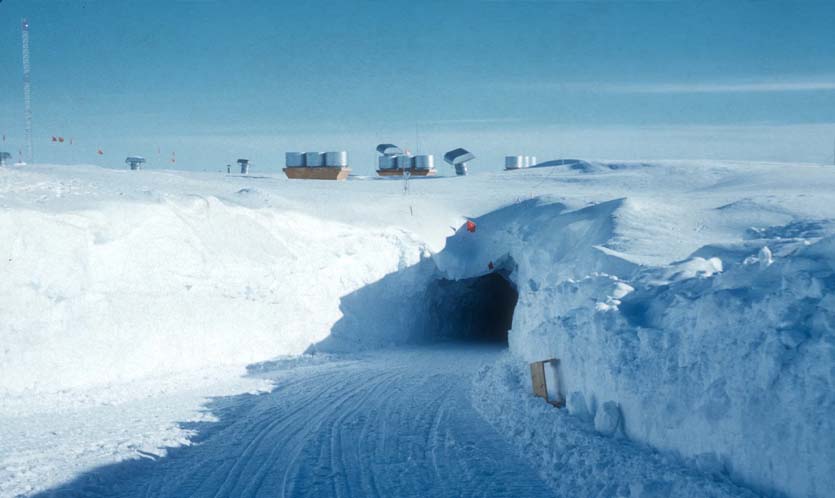
The Secret Cold War Base Under Greenland’s Ice Sheet
Introduction: A Covert Mission in the Arctic
In 1962, amid Cold War tensions, Dr. Robert Weiss was abruptly deployed to Greenland’s ice sheet. Officially, his role was to serve as a physician at Camp Century, a “research station” buried 26 feet under snow. Decades later, declassified documents revealed the base’s true purpose: a clandestine military project codenamed Iceworm, designed to hide nuclear missiles near Soviet territory. This is the story of Camp Century—a “city under the ice” with a legacy of scientific breakthroughs, Cold War intrigue, and looming environmental threats.
1. The Secret Mission of Camp Century
Camp Century, operational from 1960–1967, was marketed as a polar research hub. However, its classified objective was Project Iceworm, a Pentagon plan to install 600 nuclear missiles beneath Greenland’s ice. The Arctic’s proximity to the USSR made it a strategic launchpad, hidden in plain sight.
- Engineering Marvel: Built using giant ice trenchers, the base featured a network of tunnels housing labs, a gym, a mess hall, and even a nuclear reactor.
- Nuclear Power: A portable reactor provided energy, though early radiation leaks required lead shielding. By 1962, the site was deemed safe for its 200 occupants.
2. Life Under the Ice: Dr. Robert Weiss’s Experience
Dr. Weiss, now a Yale professor, recalls surprisingly comfortable living conditions:
- Unexpected Luxuries: Warm barracks, 10-cent martinis, and steak dinners defied the harsh environment.
- Isolation’s Toll: Despite movies and board games, the endless darkness and absence of women (only one Danish doctor visited) strained morale.
- Medical Duties: With a young, healthy crew, Weiss spent downtime studying urology textbooks and censoring films for inappropriate content.
“I could stay in the trench for weeks and never come out,” Weiss noted, describing the surreal experience of living in a nuclear-powered “city” 800 miles from the North Pole.
3. Project Iceworm: The Military’s Hidden Agenda
Declassified in the 1990s, Project Iceworm aimed to create a 2,500-mile tunnel network under Greenland for missile silos. Yet, the plan collapsed due to:
- Unstable Ice: The shifting ice sheet threatened tunnel integrity.
- Costs & Risks: Maintaining the base proved unsustainable, leading to its 1967 abandonment.
While Iceworm failed, Camp Century advanced Arctic engineering, proving long-term subterranean habitation was possible.
4. Scientific Contributions and Environmental Risks
Beyond its military role, Camp Century pioneered climate and geophysics research:
- Ice Core Discoveries: Scientists drilled 4,500 feet into the ice sheet, unlocking 120,000 years of climate data.
- Crevass Detection: Radar studies improved safety for polar expeditions.
Modern Concerns:
Climate change may resurrect Camp Century’s buried remnants. Current snow accumulation keeps the site 100+ feet under ice, but warming could expose:
- Toxic Waste: The abandoned reactor, diesel, and sewage pose contamination risks.
- Political Tensions: Greenland and Denmark, unaware of Iceworm until 1997, now face cleanup debates.
5. The Legacy of Camp Century Today
NASA’s 2023 radar imagery revealed the ghostly outline of Camp Century’s tunnels, rekindling interest in its dual history. Key takeaways include:
- Cold War Lessons: A cautionary tale of military ambition vs. environmental reality.
- Climate Science: Foundational research still informs today’s studies on ice sheet dynamics.
Conclusion: Secrets in the Ice
Camp Century’s story—of innovation, secrecy, and unintended consequences—mirrors the Cold War’s complexities. As climate change threatens to unearth its remains, the base serves as a reminder of humanity’s far-reaching impact on fragile ecosystems.
Call to Action:
What’s your take on Camp Century’s hidden history? Share this article to spark discussion, or explore our deep dive into other declassified Cold War projects.
Keywords: Camp Century, Project Iceworm, Cold War base, Arctic military, Greenland ice sheet, Robert Weiss, nuclear reactor under ice, declassified military.




